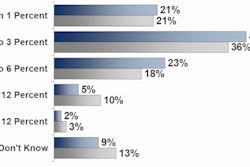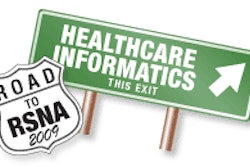The impressive capabilities of healthcare informatics to collect, query, and analyze patient and treatment-related data are starting to be understood and utilized with respect to improving the quality and safety of diagnostic imaging services.
This trend was evident in scientific sessions, posters, and educational presentations at RSNA 2009. Once they begin to proliferate, three pioneering applications presented in scientific posters may reduce the concerns associated with performing diagnostic imaging procedures that involve the use of contrast media.
Avoiding reactions
The imaging department at Massachusetts General Hospital in Boston has harnessed the capabilities of an automated semantic search engine with programmable software designed to identify symptoms of patients who most frequently have reactions to contrast agents. Developed by in-house informatics specialists, the application "flags" the files of patients for whom diagnostic imaging examinations using contrast media are planned, and estimates the risk of potential adverse reaction.
A decision-support tool called a queriable patient inference dossier (QPID) provides a lightning-fast method of reviewing a patient's records and calculating a risk assessment. In an analysis performed by fourth-year radiology resident Dr. Garry Choy and colleagues, it proved to outperform two clinicians in terms of sensitivity.
Contrast media adverse events can range from an uncomfortable case of hives to anaphylaxis to induced nephropathy. Clinical review of medical histories can help identify patients potentially at risk, but the process is time consuming, even when medical records are in electronic format.
QPID, which is a proprietary search engine, is programmed to identify patients with diabetes, heart failure, and renal disease, as well as patients who take nephrotoxic medications and/or are 70 years of age and older. It assigns a risk factor to each category and combinations of categories, generating an overall risk factor level.
At Massachusetts General Hospital, QPID recently has been used to detect more than 13,000 patients for risk factors of contrast-induced nephropathy with good results, Choy reported in an RSNA poster presentation.
During a formal analysis of two clinicians' performance assessing contrast agent reaction risk by reviewing randomly selected electronic medical records of patients, QPID demonstrated a higher sensitivity for identifying patients and predicting their risk. QPID achieved a 53% sensitivity rate; by comparison, the sensitivity rate of two clinicians was 40% and 27%. With respect to specificity, however, the clinicians outperformed QPID, at 97% compared to 69%.
QPID can also be used to identify metal objects and pacemakers as a prescreening tool for patients scheduled for MRI exams. It also is used to identify duplicate radiology examinations that have been performed within a specified time frame.
Contrast database
In spite of best efforts at maintaining patient safety when contrast agents are administered, extravasation adverse incidents do occur. A national database now exists in the U.S. to formally record these incidents and provide an analysis of how a participating hospital or imaging center compares with national averages.
The American College of Radiology (ACR) in Reston, VA, and the Society of Uroradiology in Houston have established an IV contrast extravasation registry (ICE) as one of its six registries of the ACR National Radiology Data Registry. This is part of a jointly sponsored project to develop national performance measurements and provide feedback to participating healthcare organizations.
The Society of Uroradiology developed an electronic data entry form to record key information relating to contrast extravasation incidents for radiology professionals to complete within two days of an adverse incident, and to provide a clinical outcome synopsis within two weeks following the incident. At the end of each six-month participation period, the site reports the total number of contrast-enhanced CT injections performed.
Metrics will be reported and compared with either national benchmarks or consensus-based practice guidelines. These include the extravasation rate, estimated extravasation volume for each event, and whether the event is mild, moderate, or severe.
Dr. Thomas Dykes, division chief of abdominal imaging of the department of radiology of Penn State Milton S. Hershey Medical Center in Hershey, PA, heads the CT IV contrast extravasation project. Penn State's radiology department was the first to enroll in the database in February 2009, he reported. After receiving its first six-month feedback assessment, the department made some changes in contrast administration.
To date, 13 healthcare institutions are enrolled in the registry, and both the ACR and the Society of Uroradiology are actively seeking more participants.
Automating contrast orders
Cincinnati Children's Hospital Medical Center has developed an electronic document management system to electronically manage all of the orders, documentation, and required signatures for radiology contrast administration for pediatric CT and MRI examinations. The system has increased technologist efficiency and improved patient safety, according to lead author J. A. Moskovitz.
The system was developed at the request of technologists concerned about the volume of paperwork relating to contrast agent orders, flushing lines orders, and IV documentation. Technologists were particularly concerned about the number of orders lacking signatures, which often required them to leave a patient on a CT or MRI scanner while hunting for a radiologist to sign a document.
Because technologists were also responsible for calculating manual doses of contrast media, they were concerned that an inadvertent mistake might not be caught. Additionally, approximately 3% of the paperwork volume got misplaced or was lost entirely, causing delays and creating incomplete patient records.
The electronic document management system, launched in July 2007, resolved these problems. Over an approximate two-year period, more than 81,000 orders have been electronically signed. The average time spent completing orders was reduced from 15 minutes to five minutes. Submission of the orders to the patients' medical records is now 100%.
Furthermore, the 2% error rate in manual calculation of contrast media has decreased significantly with automatic dosing calculation functionality integrated into the document management system. The system helps promote patient safety, decreases technologists' and radiologists' concern, and has made a significant contribution to improve patient efficiency.
By Cynthia E. Keen
AuntMinnie.com staff writer
December 11, 2009
Related Reading
Mayo study finds few serious reactions to CT and MR contrast, September 21, 2009
JHU study: Screening patients prior to MRI lowers NSF risk, February 4, 2009
New contrast injectors go with the digital flow, September 28, 2006
Copyright © 2009 AuntMinnie.com



















